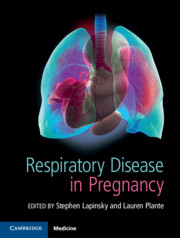Book contents
- Respiratory Disease in Pregnancy
- Respiratory Disease in Pregnancy
- Copyright page
- Contents
- Contributors
- Section 1 The Basics: for the Obstetrician
- Section 2 The Basics: for the Non-Obstetrician
- Section 3 Pulmonary Conditions Not Specific to Pregnancy
- Section 4 Pulmonary Conditions Related to Pregnancy
- 16 Dyspnoea of Pregnancy
- 17 Amniotic Fluid Embolism Syndrome
- 18 Pregnancy-Associated Pulmonary Oedema
- Section 5 Other Pulmonary Issues in Pregnancy
- Index
- References
18 - Pregnancy-Associated Pulmonary Oedema
from Section 4 - Pulmonary Conditions Related to Pregnancy
Published online by Cambridge University Press: 14 April 2020
- Respiratory Disease in Pregnancy
- Respiratory Disease in Pregnancy
- Copyright page
- Contents
- Contributors
- Section 1 The Basics: for the Obstetrician
- Section 2 The Basics: for the Non-Obstetrician
- Section 3 Pulmonary Conditions Not Specific to Pregnancy
- Section 4 Pulmonary Conditions Related to Pregnancy
- 16 Dyspnoea of Pregnancy
- 17 Amniotic Fluid Embolism Syndrome
- 18 Pregnancy-Associated Pulmonary Oedema
- Section 5 Other Pulmonary Issues in Pregnancy
- Index
- References
Summary
Pulmonary oedema (PED) is an accumulation of fluid in the lung interstitium and alveoli. PED is typically divided into cardiogenic and non-cardiogenic mechanisms. Cardiogenic PED, or congestive heart failure, occurs when the heart is unable to pump the blood returning from the lungs to the body effectively, either as a result of intrinsic heart dysfunction or external effects such as hypertension causing increased afterload. Non-cardiogenic PED, also known as acute respiratory distress syndrome (ARDS), occurs due to changes in capillary membrane permeability, resulting in the accumulation of fluid in the alveoli and interstitium. PED complicates between 0.08% and 0.5% of pregnancies.
- Type
- Chapter
- Information
- Respiratory Disease in Pregnancy , pp. 171 - 176Publisher: Cambridge University PressPrint publication year: 2020
References
- 1
- Cited by

